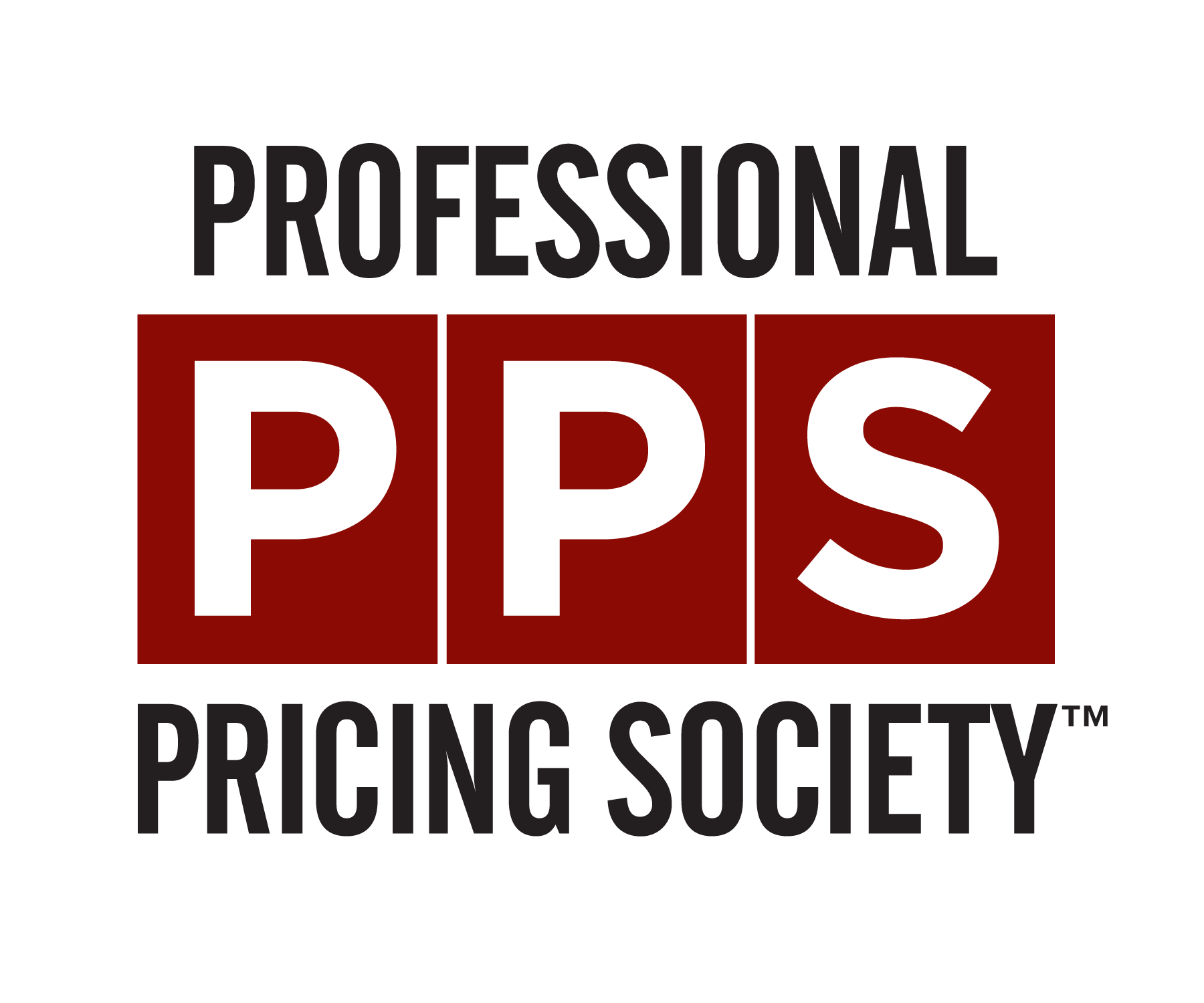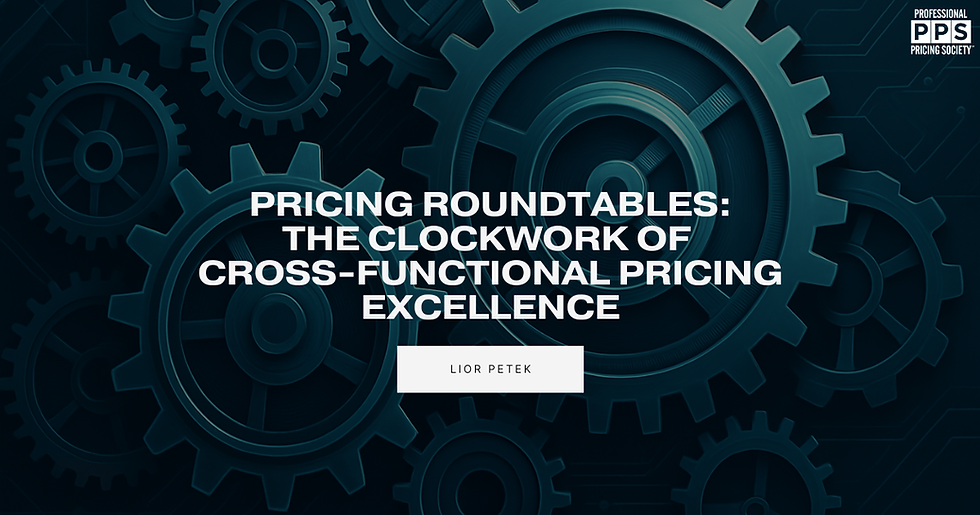The Career Value of Pricing
- terrence603
- Aug 21, 2024
- 6 min read

Laura Preslan, Lead Coach and Founder, Advoture, Inc.
Twenty years in pricing has taught me a lot. The most important lesson is that our pricing skillset is rare, difficult to cultivate, and in demand. It takes a special kind of person to excel in pricing. And when you do, it pays major dividends in career advancement, impact on your company, and personal career fulfillment. Yet, our space is not well understood, is sparsely populated with experts, and is high risk. That makes it the perfect place for a career to flourish – when you have the right skills.
We all love value pricing, so let’s apply that same concept to our careers and explore the Career Value of Pricing. And guess what? It’s high. Pricing expertise unlocks almost every other role in a company. Once you deeply understand how pricing at a company works, you can do any job in Commercial Operations (strategy, sales, marketing, customer service, business operations, etc.). Pricing skills are a catalyst for career greatness.
I have found that pricing executives (e.g., those who manage a global organization’s pricing strategy and function) master seven core skills that propel their pricing careers. The level of expertise in these seven skills changes over the years as we progress from pricing analyst to manager to leader to executive. These skills are relevant whether you want to manage an entire pricing organization or whether you prefer to be a strong individual contributor.
The Seven Skills
The seven skills are divided into technical skills and people skills. Of course some of them overlap across technical and people categories, but as pricers, we like things neat.
Technical Skills | People Skills |
Leveraging data Pattern matching Esoteric expertise
| Leadership Managing change Collaboration Storytelling |
Technical Skills
Leveraging Data: Pricers must use data to drive decision-making. A Level 1 skillset includes using Excel (the world’s most common pricing tool). Level 5 leaders own the single version of the monetization truth for their entire organization, leveraging classic as well as emerging technologies.
Pattern matching: Pricers must be able to recognize how products, services, segments, channels, and markets are similar to each other and different. This is fundamental to the simplification process of pricing. A Level 1 pricer sees recurring patterns. A Level 5 pricer ensures that all new products and services launches follow existing patterns and only create new models when the market absolutely demands it (not when a product manager says that their product is “different”).
Esoteric expertise: I am constantly amazed at how few people in organizations actually know how the company makes money. They don’t know which services are the most profitable or the value proposition of the products. Yet, they love to wax eloquent about how pricing should be done. Let’s face it. Pricing is esoteric. Level 1 pricers understand pricing concepts. Level 5 pricers understand the inter-relatedness of all products, services, contracts, subscriptions, and other aspects of monetization and lead the organization through the implementation of new business models based on that expertise.
People Skills
Leadership: You don’t have to lead a team to be a leader. Some of the best, most successful pricers I know are individual contributors who advise CEOs or prefer to be in an advisory capacity rather than team leadership. But in this case, I mean large organization leadership. We need more pricing people who can do this. Period. Level 1 leadership is managing your own work. Level 5 leadership is leading a diverse and inclusive pricing division or organization that achieves its goals with low unplanned attrition.
Collaboration: One of the most challenging parts of pricing is the massive collaboration across myriad teams. Just when you break a leader on a partner team in, they leave. Learning how to quickly develop trust and aligning goals are essential skills for career success in pricing. Level 1 pricers work effectively with their immediate team. Level 5 pricers co-create solutions across divisions in support of an aligned vision and set of goals.
Managing change: There are two core change management skills required to excel in pricing: leading through market change and implementing strategy change. When change is needed, pricing leaders lean in. We don’t have a crystal ball, so we don’t know the right answer when major market shifts happen. But our other skills make us likely candidates to get it right and use data to be agile when we aren’t. On the process and tools front, pricers who incorporate change management capabilities into their portfolio excel faster than those who throw initiatives over the wall to change management teams to implement. Level 1 pricers follow others through a change and help move it forward. Level 5 pricers lead change management initiatives and navigate market changes to deliver demonstrable business results.
Storytelling: It doesn’t matter how amazing and compelling your analysis is if you can’t explain it in a simple way. A simple graphic is way more powerful than a detailed table. A Level 1 pricer reports what happened. A Level 5 pricer effectively translates data and insights into compelling stories for executive audiences including C-level and boards.
As Albert Einstein famously said, “If you can’t explain it simply, you don’t understand it well enough.”
What It Means
The fascinating part that I have learned as I leverage this model with the pricing community is that we tend to rock the technical skills. Really rock them. And that’s great, but it relegates us to back offices and black box modelling that few can understand and leverage. Restricting yourself to the technical skills decreases the Career Value of Pricing. The magic is in the people skills. When you improve your people skills, you become a leader (be it as a manager or as an individual contributor), a visionary, and a sought-out expert.
I have done a lot of interviews of pricing analysts, pricing managers, and pricing executives to generate a typical profile for each. Every pricer’s journey and goals differ, so there is a lot of room for customization of these profiles. They provide a baseline for career path management and development.
Check out the results below. Pricing analysts tend to be skilled on the technical side. It’s growth on the people skills that set the pricing executives apart from the pricing analysts.

What You Can Do
The great, I mean, really great news is that these people skills can be learned. Pricing executives weren’t born being able to translate tables into beautiful graphics. We learned how. Many of us shied away from the spotlight or from cross-team projects because we tend towards being more introverted. If you want to maximize your Career Value of Pricing, you need to lean in on these people skills. Keep reading for some ideas on how to do that.
Self-development:
Here are a few ways that you can improve your skillset:
1. Take skill-building classes (all available on LinkedIn Learning and other platforms):
a. Giving presentations
b. Creating compelling graphics
c. People leadership
d. Leveraging AI for decision-making
2. Join Toastmasters to practice presentation skills
3. Get certified on a change management methodology, like ProSci or Design Thinking
4. Read books (links to the books are in the footnotes):
a. Switch: Change when Change is Hard
b. Multipliers: How the best leaders make everyone smarter
c. Egonomics: What Makes Ego Our Greatest Asset (or Most Expensive Liability)
d. The Pyramid Principle
Career Development
After you have figured out your maturity level on the one to five scale for each of the seven skills, there are tons of actions you can take on your own and with your manager. Here are a few:
Sign up to lead a virtual team on a strategy project:
· Review three different contracting methods to find commonalities and create a plan to unify them
· Research a different industry and leverage ideas from that industry in a stretch project
· Learn the business models for two different product or service lines and figure out a strategy to make them more similar
2. Work with your manager on a documented plan for promotion that includes:
a. The skills you must demonstrate to achieve the next level
b. How you will demonstrate those skills
c. How you will work together to identify advocates and mentors
d. A timeline
3. Work with a career coach to define your future vision and how to achieve it; many companies offer this or will allow you to use your training budget to hire a career coach
Conclusion
In my presentation at the Fall Conference, I will share the instrument (I don’t like calling it a test or assessment) that you can use to figure out where you are on the maturity level for each of the seven skills. It will help you understand where to invest your training time, effort, and your companies’ dollars to maximize your Career Value of Pricing.




